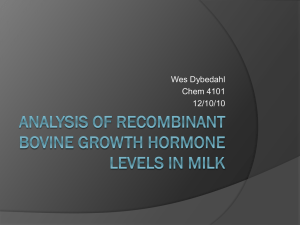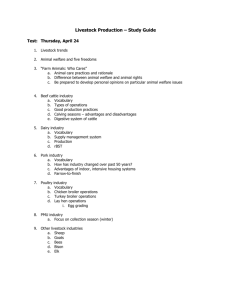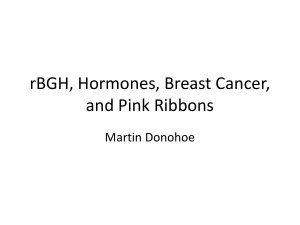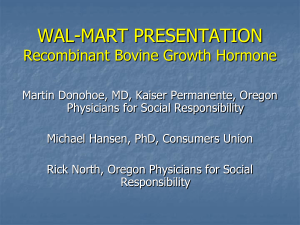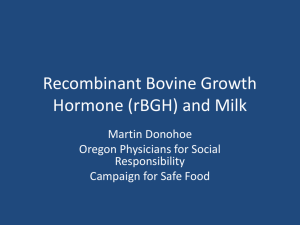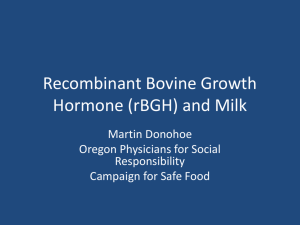Precautionary avoidance of hormone growth promoters in beef and
advertisement
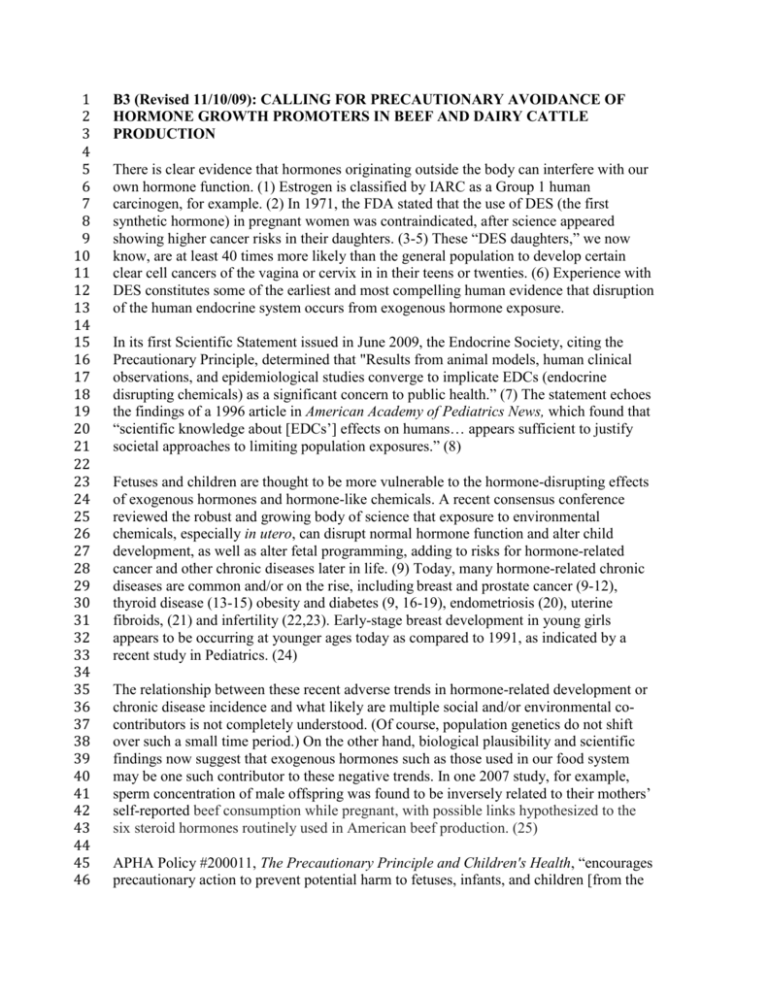
1
2
3
4
5
6
7
8
9
10
11
12
13
14
15
16
17
18
19
20
21
22
23
24
25
26
27
28
29
30
31
32
33
34
35
36
37
38
39
40
41
42
43
44
45
46
B3 (Revised 11/10/09): CALLING FOR PRECAUTIONARY AVOIDANCE OF
HORMONE GROWTH PROMOTERS IN BEEF AND DAIRY CATTLE
PRODUCTION
There is clear evidence that hormones originating outside the body can interfere with our
own hormone function. (1) Estrogen is classified by IARC as a Group 1 human
carcinogen, for example. (2) In 1971, the FDA stated that the use of DES (the first
synthetic hormone) in pregnant women was contraindicated, after science appeared
showing higher cancer risks in their daughters. (3-5) These “DES daughters,” we now
know, are at least 40 times more likely than the general population to develop certain
clear cell cancers of the vagina or cervix in in their teens or twenties. (6) Experience with
DES constitutes some of the earliest and most compelling human evidence that disruption
of the human endocrine system occurs from exogenous hormone exposure.
In its first Scientific Statement issued in June 2009, the Endocrine Society, citing the
Precautionary Principle, determined that "Results from animal models, human clinical
observations, and epidemiological studies converge to implicate EDCs (endocrine
disrupting chemicals) as a significant concern to public health.” (7) The statement echoes
the findings of a 1996 article in American Academy of Pediatrics News, which found that
“scientific knowledge about [EDCs’] effects on humans… appears sufficient to justify
societal approaches to limiting population exposures.” (8)
Fetuses and children are thought to be more vulnerable to the hormone-disrupting effects
of exogenous hormones and hormone-like chemicals. A recent consensus conference
reviewed the robust and growing body of science that exposure to environmental
chemicals, especially in utero, can disrupt normal hormone function and alter child
development, as well as alter fetal programming, adding to risks for hormone-related
cancer and other chronic diseases later in life. (9) Today, many hormone-related chronic
diseases are common and/or on the rise, including breast and prostate cancer (9-12),
thyroid disease (13-15) obesity and diabetes (9, 16-19), endometriosis (20), uterine
fibroids, (21) and infertility (22,23). Early-stage breast development in young girls
appears to be occurring at younger ages today as compared to 1991, as indicated by a
recent study in Pediatrics. (24)
The relationship between these recent adverse trends in hormone-related development or
chronic disease incidence and what likely are multiple social and/or environmental cocontributors is not completely understood. (Of course, population genetics do not shift
over such a small time period.) On the other hand, biological plausibility and scientific
findings now suggest that exogenous hormones such as those used in our food system
may be one such contributor to these negative trends. In one 2007 study, for example,
sperm concentration of male offspring was found to be inversely related to their mothers’
self-reported beef consumption while pregnant, with possible links hypothesized to the
six steroid hormones routinely used in American beef production. (25)
APHA Policy #200011, The Precautionary Principle and Children's Health, “encourages
precautionary action to prevent potential harm to fetuses, infants, and children [from the
1
2
3
4
5
6
7
8
9
10
11
12
13
14
15
16
17
18
19
20
21
22
23
24
25
26
27
28
29
30
31
32
33
34
35
36
37
38
39
40
41
42
43
44
45
46
continued manufacture and use of substances], even if some cause and effect
relationships have not been established with scientific certainty.” (26) APHA has
reiterated its support for the Precautionary Principle in other policy, as well. (27) Because
children cannot choose to avoid food, and because the use of exogenous hormone growth
promoters in beef and dairy production is unnecessary, this policy resolution lays out a
precautionary rationale and scientific evidence for public health action to remove these
food production uses of exogenous hormones.
Synthetic hormones in beef production
From FDA approval in 1954 until 1979, DES continued to be used as a growthpromoting synthetic estrogen in beef cattle production even after its human uses were
halted (28). Three natural steroid hormones – estradiol, testosterone and progesterone,
and three synthetic surrogates (zeranol, melengestrol, trenbolone) remain in widespread
use by U.S. and Canadian beef cattle producers to boost growth and production (25, 29);
concurrent use of more than one steroid is approved. (30) One of them, trenbolone, is
thought to have 8-10 times greater anabolic activity than testosterone. (31) It is widely
acknowledged that the use of these hormone growth promoters results in residues in
meat. (32, 33)
Residues of these hormone growth promoters also persist for weeks to months in manure
and in feedlot runoff, raising concerns about the added exogenous hormone load to the
environment. (34, 35)
Since 1988, use of steroid hormones in cattle production has been illegal in Europe. (33)
According to the European Commission’s Scientific Committee on Veterinary Measures
Related to Public Health, the decision to ban the use of such hormones was “based on the
accumulating evidence on the fragility of the endocrine equilibrium in all stages of life as
well as the potential genotoxicity of these compounds and their metabolites.” The
Commission continues, “Exogenous hormone exposure may disrupt this delicate
equilibrium as is evidenced by the pronounced effects of oestrogens and testosterone on
functional imprinting. Thus even exposure to residual amounts of hormonally active
compounds as present in meat and meat products needs to be evaluated in terms of
potentially adverse effects to public health.”(36)
By contrast, the U.S. government position is that hormone residues in beef from adult
cattle pose no threat to human health. This assumption of safety, however, has remained
untested by long-term epidemiologic studies and instead relies on dated research
concerning the ability of estrogen (estradiol) to mutate genes. It fails to reflect more
recent research that hormones and hormonally-active chemicals may exert their toxicity
instead via epigenetic changes. (23, 37)
rbGH use in dairy production
Since 1994, recombinant bovine growth hormone, also known as rbGH or rbST, has been
injected into dairy cows to increase milk production, typically to increase production by
an average of 11-15%. (38) rbGH was developed and marketed by Monsanto and sold to
Elanco, a division of Eli Lilly, in October 2008. Though approved by the FDA in a
1
2
3
4
5
6
7
8
9
10
11
12
13
14
15
16
17
18
19
20
21
22
23
24
25
26
27
28
29
30
31
32
33
34
35
36
37
38
39
40
41
42
43
44
45
46
controversial November 1993 decision, both Canada and the European Union in 1999
refused to approve the drug’s use, officially citing harm to cows’ health. (39, 40) No
significant scientific studies since then have led these bodies to reconsider their stance.
Australia, New Zealand and Japan have also prohibited its use. (41, 42)
Although some studies (including a number funded by Monsanto) have failed to
demonstrate that rbGH harms dairy cows, (43) virtually all independent analyses of the
data reached a different conclusion. (44) In addition to the Canadian and European
studies, the FDA’s analysis of the data submitted by Monsanto demonstrated that use of
rbGH increases the incidence of sixteen different harmful conditions in cows, including
birth disorders, hoof problems, heat stress, diarrhea, increased somatic cell count and
mastitis, a painful udder infection. (45) Based on this evidence, the FDA requires these
risks be listed on rbGH package inserts, but not on finished dairy products. (45) Virtually
all animal-welfare organizations, including the Humane Society of the United States and
the Humane Farming Association, oppose the use of rbGH. (46)
rbGH use presents an additional risk to human health in the form of antibiotic resistance.
As more cows develop mastitis due to rbGH use, farmers necessarily increase their use of
antibiotics to treat the udder infections. (47) There is now a consensus among scientists
that antibiotic use in farm animals increases antibiotic resistance, which can then be
transmitted back to humans through bacteria on food or in the environment. (48, 49)
Reducing rbGH use would serve to reduce antibiotic use in dairy cattle.
Scientific committees for Health Canada and the European Commission have also raised
concerns about the potential effects of rbGH on cancer. (50, 51) Insulin-like Growth
Factor-1 (IGF-1) is a necessary growth hormone present and identical in both cows and
humans. However, elevated IGF-1 levels in human blood are associated with higher rates
of colon, breast, and prostate cancers. (52-54) Based on data submitted by Monsanto, the
FDA determined that rbGH use raises levels of IGF-1 in cow’s sera and cow’s milk. (55)
These data also show that IGF-1 survives pasteurization. (56) Animal models show that
most IGF-1 in cow’s milk survives digestion, reaching the bloodstream where it may
promote cancer (57-59). The U.N.’s main food safety body, the Codex Alimentarius
Commission, determined in 1999 that rbGH could not be declared safe for human health.
(60)
In recent years, more and more U.S. public health organizations have taken formal
stances opposing the drug, including Oregon Physicians for Social Responsibility (2003),
Health Care Without Harm (2005), and the American Nurses Association (2008). (6163). In the past three years, more than 230 U.S. hospitals have signed a pledge
committing to serve rbGH-free dairy products. (64)
A 2008 national poll showed that more than 90% of consumers favor labeling of rbGHfree products. (65) Responding to this concern, many large retail establishments including Wal-Mart - have phased out their milk brands produced using rbGH. (66) Milk
and many other dairy products from cows not treated with rbGH are now widely
available; rbGH use fell from 22% of U.S. farms in 2003 to 15% in 2007. (67) Use of the
1
2
3
4
5
6
7
8
9
10
11
12
13
14
15
16
17
18
19
20
21
22
23
24
25
26
27
28
29
30
31
32
33
34
35
36
37
38
39
40
41
42
synthetic hormone is still common practice on many large dairy operations, however. In
2007, nearly 43% of large herds were treated with rbGH. (67)
In February 2007, Monsanto appealed unsuccessfully to the FDA and the Federal Trade
Commission to restrict the labeling of rbGH-free milk. Since then, policymakers in eight
states have attempted to ban or restrict the labeling of rbGH-free dairy products through
bills or administrative rules. All failed except in Ohio, where the proposed rules are being
challenged in court.
Medical authorities and foreign governments have documented scientific public health
concerns associated with rbGH use. As long as the FDA allows rbGH to remain on the
market, consumers should have the “right to know” if it is present or absent in dairy
products they consume. This right to know about hazardous or controversial substances
has been defended in APHA Policy 2002-5. (68)
A precautionary approach to hormone growth promoters in beef and dairy cattle
production
Consistent with its explicit endorsement of the Precautionary Principle, the American
Public Health Association is therefore opposed to the use of hormone growth promoters
in beef and dairy cattle production, and strongly recommends that:
1.
The FDA act with public health precaution to ban their use on the basis of certain
exposure and possibility of human health risks, pending long-term epidemiological
data demonstrating such exposures to be without harm to workers and/or the
population as a whole.
2.
Hospitals, schools and other institutions, especially those serving children,
preferentially purchase food products from beef and dairy cattle produced without
such hormones.
3.
Companies producing and retailers offering products produced without rbGH or
other hormones retain the right to label such products in an easily readable and
understandable fashion so that consumers in the free marketplace can be equipped to
make an informed choice about which brands to buy.
4.
APHA support increased federal research to better delineate mechanisms of harm
from hormone-disrupting chemicals in food and the environment, and to assess the
cumulative public health impact from low-level exposure to multiple such chemicals,
including to fetuses and children.
References:
1) Colborn T, Dumanoski D, Myes JP. 1996. Our Stolen Future. Dutton, Penguin Books.
2) International Agency for Research on Cancer. 2007. Combined Estrogen-Progestogen Contraceptive
and Combined Estrogen-Progestogen Menopausal Therapy. IARC Monographs on the Evaluation of
Carcinogenic Risks to Humans. 91.
3) Swan SH. Intrauterine exposure to diethylstilbestrol: long-term effects in humans. APMIS. 2000
Dec;108(12):793-804.
4) EXTOXNET website. Questions about endocrine disruptors, a pesticide information project of Cornell
University, Michigan State University, Oregon State University, and University of California at Davis.
Accessed 21 May 2009 at http://extoxnet.orst.edu/faqs/pesticide/endocrine.htm.
5) Reigart R. Cummins S. Limit hormone-disrupting chemical exposure. AAP News 1996;12:17.
6) Centers for Disease Control and Prevention website. Health Risks and Related Concerns for DES
Daughters. Accessed March 11, 2008 at
www.cdc.gov/DES/hcp/information/daughters/risks_daughters.html.
7) Diamanti-Kandarakis E, Bourguignon JP, Giudice LC, Hauser R, Prins GS, Soto AM, Zoeller RT,
Gore AC. Endocrine-disrupting chemicals: An Endocrine Society scientific statement. Endocrine
Reviews 2009 30(4):293-342
8) Reigart, R, and S Cummins. Limit hormone-disrupting chemical exposure. AAP News 1996 12(4): 17
9) Grandjean P, Bellinger D, Berman A, Cordler S, Davey-Smith G, Eskenazi B, Gee B, Gray K,
Hanson M, van den Hazel P, Heindel JJ, Heinzow B, Hertz-Picciotto I, Hu H, Huang T T-K, Jensen
TK, Landrigan PJ, McMillen IC, Murata K, Ritz B, Schoeters G, Skakkebæk NE, Skerfving S,
Weihe P. The Faroes Statement: Human Health Effects of Developmental Exposure to Chemicals in
Our Environment. Basic & Clinical Pharmacology & Toxicology 2008;102:73–75
10) Cowin, PA, P Foster, J Pedersen, S Hedwards, SJ McPherson, GP Risbridger. 2008. Early onset
endocrine disruptor induced prostatitis in the rat. Environment Health Perspect 116:923–929.
11) Gray, LE, VS Wilson, TS Stoker, C Lambright, J Furr, N Noriega, K Howdeshell, GT Ankley and LJ
Guillette. 2006. Adverse effects of environmental antiandrogens and androgens on reproductive
development in mammals. International Journal of Andrology 29:96-104.
12) vom Saal, FS, SM Belcher, LJ Guillette, R Hauser, JP Myers, GS Prins, WV Welshons, JJ Heindel et
al. 2007. Chapel Hill Bisphenol A Expert Panel Consensus Statement: Integration of mechanisms,
effects in animals and potential impact to human health at current exposure levels. Reprod Toxicol
24:131-138.
13) Meeker JD, Calafat AM, Hauser R. Di(2-ethylhexyl) phthalate metabolites may alter thyroid
hormone levels in men. Environ Health Perspect. 2007 Jul;115(7):1029-34.
14) Crofton KE,Craft ES, Hedge JM, Gennings C, Simmons JE, Carchman RA, Carter Jr. WH, DeVito
MJ. 2005. Thyroid Hormone Disrupting Chemicals: Evidence for Dose-Dependent Additivity or
Synergism, Environ Health Perspect. 113(11):1549-54.
15) Davey JC, Nomikos AP, Wungjiranirun M, Sherman JR, Ingram L, Batki C, Lariviere JP, Hamilton
JW. 2008. Arsenic as an endocrine disruptor: arsenic disrupts retinoic acid receptor-and thyroid
hormone receptor-mediated gene regulation and thyroid hormone-mediated amphibian tail
metamorphosis. Environ Health Perspect.116(2):165-72.
16) Ruhlen RL, KL Howdeshell, J Mao, JA Taylor, FH Bronson, RR Newbold, WV Welshons and FS
vom Saal. 2008. Low phytoestrogen levels in feed increase fetal serum estradiol resulting in the
“fetal estrogenization syndrome” and obesity in CD-1 mice. Environ Health Perspect 116:322–328.
17) Smink, A, N Ribas-Fito, M Torrent, MA Mendez, JO Grimalt and J Sunyer. 2008. Exposure to
hexachlorobenzene during pregnancy increases the risk of overweight in children aged 6 years. Acta
Pediactrica, in press.
18) Hugo, ER, TD Brandebourg, JG Woo, J Loftus, JW Alexander and N Ben-Jonathan. 2008. Bisphenol
A at Environmentally Relevant Doses Inhibits Adiponectin Release from Human Adipose Tissue
Explants and Adipocytes. Environl Health Perspect doi:10.1289/ehp.11537 available via
http://dx.doi.org/ . Accessed August 14, 2008.
19) Iain A. Lang, PhD; Tamara S. Galloway, PhD; Alan Scarlett, PhD; William E. Henley, PhD; Michael
Depledge, PhD, DSc; Robert B. Wallace, MD; David Melzer, MB, PhD. 2008. Association of
Urinary Bisphenol A Concentration With Medical Disorders and Laboratory Abnormalities in Adults
.JAMA 300(11):1303-1310.
20) Rier, S and WG Foster. 2002. Environmental dioxins and endometriosis. Toxicological Sciences
70:161-170.
21) Newbold, RR, WR Jefferson, and EP Banks. 2007. Long-term Adverse Effects of Neonatal Exposure
to Bisphenol A on the Murine Female Reproductive Tract. Reproductive Toxicology 24:253-258.
22) Hauser, R, JD Meeker, S Duty, MJ Silva and AM Calafat 2006. Altered Semen Quality in Relation to
23)
24)
25)
26)
27)
28)
29)
30)
31)
32)
33)
34)
35)
36)
37)
38)
39)
40)
41)
42)
43)
Urinary Concentrations of Phthalate Monoester and Oxidative Metabolites. Epidemiology 17: 682–
691.
Swan, SH, RL Kruse, L Fan, DB Barr, EZ Drobnis, JB Redmon, C Wang, C Brazil and JW
Overstreet and the Study for the Future of Families Research Group. Semen quality in relation to
biomarkers of pesticide exposure. Environt Health Perspect 2003 111:1478-1484.
Aksglaede L, Sorensen K, Petersen JH., Skakkebaek NE, Juul A. Recent Decline in Age at Breast
Development: The Copenhagen Puberty Study. Pediatrics 2009 123: e932-e939.
Swan SH, Liu F, Overstreet JW, Brazil C, Skakkebæk NE. Semen quality of fertile US males in
relation to their mothers' beef consumption during pregnancy. Hum Reprod 2007 22(6):1497–1502.
APHA Policy # #200011, The Precautionary Principle and Children's Health. January 1, 2000;
accessed June 2, 2009. Available at
http://www.apha.org/advocacy/policy/policysearch/default.htm?id=216.
APHA Policy #20009, Support for International Action to Eliminate Persistent Organic Pollutants.
January 1, 2000; accessed June 2, 2009. Available at
http://www.apha.org/advocacy/policy/policysearch/default.htm?id=214
Office of Technology Assessment. Drugs in Livestock Feed (NTIS order #PB-298450). U.S.
Government Printing Office: Washington, DC, 1979.
www.princeton.edu/~ota/disk3/1979/7905/790504.PDF. Accessed October 6, 2008. 138-139
Meyer HH. Biochemistry and physiology of anabolic hormones used for improvement of meat
production. APMIS 2001;109:1–8.
Orr R. Growth-promoting hormones in cattle. International Food Safety Network, Kansas State
University, 2001. Accessed November 7, 2009. Available at http://foodsafety.k-state.edu/en/articledetails.php?a=4&c=19&sc=162&id=308.
Lange IG, Daxenberger A, Schiffer B, Witters H, Ibarreta D, Meyer HHD. Sex hormones originating
from different livestock production systems: fate and potential disrupting activity in the environment.
Anal Chim Acta 2002, 473:27–37
Henricks DM, Gray SL, Owenby JJ et al. Residues from anabolic preparations after good veterinary
practice. APMIS 2001;109:273–83.
Stephany RW. Hormones in meat: different approaches in the EU and in the USA. APMIS
2001;109:S357–S363.
Schiffer B, Daxenberger A, Meyer K, Meyer HHD. The Fate of Trenbolone Acetate and
Melengestrol Acetate after Application as Growth Promoters in Cattle: Environmental Studies.
Environ Health Perspect 109:1145–1151
Soto AM, Calabro JM, Prechtl NV, Yau AY, Orlando EF, Daxenberger A, Kolok AS, Guiletter LJ,
Bizec B Lange IG, Sonnenschein C. Androgenic and Estrogenic Activity in Water Bodies Receiving
Cattle Feedlot Effluent in Eastern Nebraska, USA. Environ Health Perspect 2004; 112:346–352
European Commissions. Scientific Committee on Veterinary Measures Relating To Public Health:
Assessment of Potential Risks to Human Health from Hormone Residues in Bovine Meat and Meat
Products (April 30, 1999). Accessed 22 May 2009. Available at
http://ec.europa.eu/food/fs/sc/scv/out21_en.pdf.
vom Saal, FS, SM Belcher, LJ Guillette, R Hauser, JP Myers, GS Prins, WV Welshons, JJ Heindel et
al. 2007. Chapel Hill Bisphenol A Expert Panel Consensus Statement: Integration of mechanisms,
effects in animals and potential impact to human health at current exposure levels. Reprod Toxicol
24:131-138.
Dohoo I et al, A Meta-Analysis review of the effects of recombinant bovine somatotropin, Canadian
Journal of Veterinary Research 2003;67(4):241-251.
Dohoo I et al, Report of the Canadian Veterinary Medical Association expert panel on rBST,
November 1998, www.hc-sc.gc.ca, section 7.
Broom D et al, Report of the (European Union) Scientific Committee on Animal Health and Animal
Welfare on Aspects of the Use of Bovine Somatotropin, March 1999, http://europa.eu.int
Japan Ministry of Health, Labour and Welfare. 2004. Ministerial Ordinance on Milk and Milk
products Concerning Compositional Standards. February 5
Food Standards Australia and New Zealand. 2006. A Risk Profile of Dairy Products in Australia:
Food Standards Australia New Zealand. August 9.
Bauman D et al, Production Response to Bovine Somatotropin in Northeast Dairy Herds. Journal of
Dairy Science 1999;82:2564-2573
44) Kronfeld DS, Recombinant bovine somatotropin and animal welfare, Journal of the American
Veterinary Medical Association 2000;11(216):1719-1722
45) United States Food and Drug Administration, Freedom of Information summary for Posilac®,
November 1993, Section 6-j
46) See, for example, Siebert, L, et al. Letter to Governor Kathleen Sebelius. April 8, 2009. Accessed
November 7, 2009. Available at http://www.consumersunion.org/pub/core_food_safety/010910.html.
47) Zwald, AG et al, Management practices and reported antimicrobial usage on conventional and
organic dairy farms, Journal of Dairy Science 2004;87:191-201.
48) Aarestrup FM, Wegener HC, Collignon P. Resistance in bacteria of the food chain: epidemiology
and control strategies. Expert Rev. Anti Infect.Ther. 2008;6(5):733-750.
49) APHA Antibiotic Resistance Factsheet. Available at
www.apha.org/advocacy/reports/facts/advocacyfactantibiotic.htm?NRMODE=Published&NRNODE
G UID=%7b994096E5-45B0-46B5-B757D61D499A16B3%7d&NRORIGINALURL=%2fadvocacy%2freports%2ffacts%2fadvocacyfactantib
i otic&NRCACHEHINT=NoModifyGuest&PF=true167 168 169. March 2003; accessed June 2,
2009.
50) Health Canada, rBST Gaps Analysis Report. April 21, 1998.
51) The European Commission, Report on Public Health Aspects of the Uses of Bovine Somatotropin,
“Food Safety: From the Farm to the Fork,” March 15-16, 1999.
52) Yu H and Rohan T, Role of the Insulin-Like Growth Factor Family in Cancer Development and
Progression, Journal of the National Cancer Institute 2000;92(18):1472-1489.
53) Moschos S and Mantzoros C, The Role of the IGF System in Cancer: From Basic to Clinical Studies
and Clinical Applications, Oncology2002; 63(4):317-332.
54) Roddam AW, Allen NE, Appelby P, Key TJ, Ferrucci L, et al. Insulin-like growth factors, their
binding proteins, and prostate cancer risk: analysis of individual patient data from 12 prospective
studies. Ann Intern Med. 2008 Oct 7; 149(7):461-71, W83-8.
55) United States Food and Drug Administration, Freedom of Information summary for Posilac®,
November 1993, Section 7 a-f.
56) Juskevich, JC and CG Guyer. Bovine Growth Hormone: Human food safety evaluation. Science
1990;249:875-884.
57) Kimura T et al, Gastrointestinal absorption of recombinant human insulin-like growth factor-1 in
rats, Journal of Pharmacology and Experimental Therapeutics1997;283:611-618.
58) Xian, C et al, Degradation of IGF-1 in the adult rat gastrointestinal tract is limited by a specific
antiserum or the dietary protein casein, Journal of Endocrinology 1995;146:215-225
59) Anderle, P et al, In Vitro Assessment of Intestinal IGF-1 Stability, Journal of Pharmaceutical
Sciences 2002;91:1.
60) Codex Alimentarius Commission, Report: Twenty-Third Session, June 28 – July 3, 1999, FAO
Headquarters, Rome, pp. 3-14.
61) Health Care Without Harm, www.noharm.org/details.cfm?ID=1104&type=document.
62) Oregon Physicians for Social Responsibility,
www.psr.org/site/PageServer?pagename=oregon_safefood, 2008.
63) American Nurses Association,
www.nursingworld.org/FunctionalMenuCategories/MediaResources/PressReleases/2008PR.aspx,
July 1, 2008 press release.
64) Health Care Without Harm website, http://www.noharm.org/us/food/pledge, accessed June 6, 2009
65) Consumer Reports National Research Center, Food Labeling Poll 2008, November 2008.
66) Wal-Mart Stores. 2008. Wal-Mart Offers Private Label Milk Produced without Artificial Growth
Hormone. March 23. Accessed November 7, 2009. Available at
http://walmartstores.com/FactsNews/NewsRoom/8147.aspx
67) United States Department of Agriculture, Dairy 2007, October 2007.
68) APHA policy # 2002-5. Preserving Right-To-Know Information and Encouraging Hazard Reduction
to Reduce the Risk of Exposure to Toxic Substances. Available at
http://www.apha.org/APHA/CMS_Templates/PolicySearch.aspx?NRMODE=Published&NRNODE
GUID={40FCA601-747E-4190-936BBBB2DB8CDD36}&NRORIGINALURL=%2fadvocacy%2fpolicy%2fpolicysearch%2f&NRCACH
EHINT=NoModifyGuest. 2002; accessed June 2, 2009.


